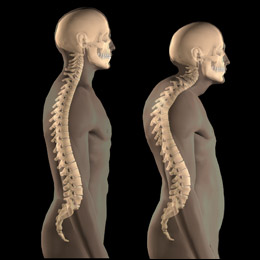Like a honeycomb, our bones (which contain spongy and compact bone) possess the same traits in that they have little holes. However, if the holes inside the bone are too big and spaced out unevenly, you should go to the doctor's and ask for a bone density test: you may have osteoporosis.
Osteoporosis is a disease in the bone where either a person does not make enough bone, produces too little, or both. While mainly found in women aged 50+, men aged 50+ are susceptible to it too.
Osteoporosis can be very life threatening because if a person's bones are too weak, any little bump or movement can break a bone and cause lasting pain. Factors that lead to osteoporosis commonly include a lack of calcium and vitamin D, not eating healthy, not getting enough exercise and other controllable factors. Some factors one cannot control, however, include aging, genetics and body built (being weak/small). Having a healthy lifestyle goes a long way, especially in preventing osteoporosis.
Like my physiology teacher says, the body and what happens to it is a cycle that affects not just one system or place, but many others as well. That being said, there are diseases that cause osteoporosis or can make it much worse. To name a few: RA arthritis, inflammatory bowl disease, diabetes, leukemia, depression and many other diseases can lead or worsen osteoporosis in any victim. Certain medicines, too, can cause osteoporosis, with diagnoses not occurring until much later.
Medicines Approved to Prevent and/or Treat Osteoporosis
| Class and Drug | Brand Name | Form | Frequency |
| Bisphosphonates | |||
| Alendronate | Generic Alendronate and Fosamax® | Oral (tablet) | Daily/Weekly |
| Alendronate | Fosamax Plus D™ (with 2,800 IU or 5,600 IU of Vitamin D3) | Oral (tablet) | Weekly |
| Ibandronate | Boniva® | Oral (tablet) | Monthly |
| Ibandronate | Boniva® | Intravenous (IV) injection | Four Times per Year |
| Risedronate | Actonel® | Oral (tablet) | Daily/Weekly/Twice Monthly/Monthly |
| Risedronate | Actonel® with Calcium | Oral (tablet) | Weekly |
| Risedronate | Atelvia TM | Oral (tablet) | Weekly |
| Zoledronic Acid | Reclast® | Intravenous (IV) infusion | One Time per Year/Once every two years |
| Calcitonin | |||
| Calcitonin | Fortical® | Nasal spray | Daily |
| Calcitonin | Miacalcin® | Nasal spray | Daily |
| Calcitonin | Miacalcin® | Injection | Varies |
| Estrogen* | |||
| Estrogen | Multiple Brands | Oral (tablet) | Daily |
| Estrogen | Multiple Brands | Transdermal (skin patch) | Twice Weekly/Weekly |
| Estrogen Agonists/Antagonists Also called Selective Estrogen Receptor Modulators (SERMs) | |||
| Raloxifene | Evista® | Oral (tablet) | Daily |
| Parathyroid Hormone | |||
| Teriparatide | Forteo® | Injection | Daily |
| RANK ligand (RANKL) inhibitor | |||
| Denosumab | ProliaTM | Injection | Every 6 Months |
Source 1
Source 2



